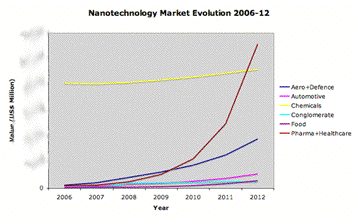Home > Nanotechnology Columns > UAlbany College of Nanoscale Science and Engineering > CNSE and the birth of NanoEconomics
 |
Ed Cupoli CNSE Head of Nanoeconomics Constellation UAlbany College of Nanoscale Science and Engineering |
Abstract:
NanoEconomics is the branch of economics that studies the creation and distribution of wealth related to the technological changes brought by nanotechnology. NanoEconomics focuses on understanding the extent of the change that will be brought upon not by a single field of science research but by the convergence of many. Due to the extraordinary amount of innovation that is being generated by nanotechnology as a result of the positive cross-linkages between highly competitive industries (i.e. semiconductor, information technology and pharmaceutical industries), it can be foreseen that to study NanoEconomics is to study the new paradigms in the next industrial revolution.
September 15th, 2007
CNSE and the birth of NanoEconomics
The history of mankind is one of innovation and change. However change does not happen at a constant rate. Historically, each new technology introduced over time has penetrated established markets at a faster rate than its predecessor. The time that it has taken successive technologies to penetrate one quarter of the overall U.S. consumer market has declined from 55 years (for the automobile) to 7 years (for the Internet). For us, this means that today we can witness and study the birth, introduction and impact of many new technologies.
The purpose of new technologies is to solve problems. When we solve a problem using a new technology it is either to improve our quality of life or to help us create more value in our everyday labor. Whatever the case, new technologies drives us to do things in a better manner and consequently, makes us in general more productive.
 |
Productivity is the effectiveness of productive effort. With passing centuries our conception of productivity has changed dramatically. Moreover, with the advent and growth of the computer and information technology industries in the last 40 years we have witnessed a tremendous technological change. The convergence of computing, information and communications is transforming every aspect of society and creating new possibilities for improved productivity. The productivity in the semiconductor industry is and has been, for several decades, a driving force for the economic growth of the world. Productivity growth in the semiconductor industry has averaged 20 percent for the last 10 years, compared to less than 5 percent for all manufacturing industries.
Productivity in this industry is inevitably related to Moore's Law, meaning the regular increase in performance and data processing capabilities in computer chips. Moore's Law is the engine for continued growth, an engine not to be found in any other industry on the planet. Furthermore, this increase in productivity has occurred hand in hand with a decline in consumer prices. The price of a single transistor was $1.00 in 1968 . Today you can buy millions of transistors for $1.00. What other item has declined in price like the transistor?
 |
Source: Intel.
The semiconductor industry adds over $300 billion a year to the U.S. economy . Knowing that this vast industry is not only fundamental as a creator of wealth but also as a driver for development, given by productivity via innovation, several U.S. states have recognized the importance of actively and aggressively participating as key players in this ongoing technological and economic revolution. Consequently, the State of New York's commitment to the development challenge was aggressively enhanced by the creation of the Centers of Excellence Program in 2000. This program was structured to improve comparative advantages with incentives to leverage private sector funds and know how with public funds. The guidelines of the program required that the centers focused on a specific area of high technology.
One of the initiatives that emerged in the Capital Region was the Albany Center of Excellence, with a designated focus in research and development in the area of Nanoelectronics. The Albany model focuses on exploring the synergetic effects of the creation of a nanoelectronics cluster. It started as major magnet for skilled labor and produced a net insourcing of jobs. It did so by partnering with strategic corporations of the semiconductor industry, namely IBM and the largest manufacturers of semiconductor equipment: Applied Materials, Tokyo Electron and ASML. Today, there are over 150 more industrial partners working as part of the New York State Center of Excellence in Nanoelectronics. In the semiconductor industry, where research and development costs grow at an exponential rate and the complexity is so great that no one company can achieve all dimensions themselves, the clustering and partnering strategy developed by the Albany model has proven to be successful, intelligent and necessary.
 |
As a natural development and only a few years after the appointment of the Center of Excellence, the College of Nanoscale Science and Engineering (CNSE) was founded. The CNSE was created to be the first college in the world dedicated to the education of the 21st century workforce. It was created as a new educational model: to teach in an interdisciplinary fashion, putting science, engineering, bio and economics in the same place. To achieve this and with a clear objective to reject the silo method of traditional university programs, constellations in NanoScience, NanoEngineering, NanoBioscience and NanoEconomics were created and appointed to work to serve in the development of the same universe: the one teaching and researching nanotechnology. At CNSE, the study of science is not for science sake but rather to advance commercialization of technology and prepare the workforce to meet future needs.
The creation of such a college and its unique nanotechnology focus has created a critical mass of scientists and researchers, with a path for new entrants to the region's workforce. The professors and students focus on research in many of the critical path areas involving nanotechnology. The university provides an environment for students, professors, industry and the surrounding community to learn, innovate and transform such knowledge into new wealth. The college educates more trained scientists and engineers every year, helping businesses move forward. The college is the model of the knowledge intensive economy in which all actors of society work in an R&D, capital intensive and high-wage industry, which requires the input of high value added support industries to periodically reinvent itself.
The creation of this highly complex and effective technology ecosystem serves also an altruistic purpose: to stimulate the creation of economic activities that add great value to society and to continuously improve the well-being of all surrounding economic actors, by encouraging a unique confluence of entrepreneurial spirit, political will, business desire and an over arching discipline. The societal effects of such revolutionary models are not unknown: Silicon Valley in California, Route 128 in Boston and the economic miracle of the East Asian economies are just a few examples. The large-scale societal impacts of technology and innovation are bedazzling, and are inevitably encouraging us to dig deep to understand the core components that have brought about such amazing economic transformations. To fully understand the large-scale economic miracles of individual revolutionary technologies it is necessary to understand the process in its whole, from the attainment of the scientific knowledge to the transformation of our modern societies.
Economic studies have always been concerned with the transformation of our basic resources to produce goods and services, in other words with technology. Never before as now is this transformation more important and more relevant to the challenge of development. In understanding the complexity of the transformation of resources, which we now know goes beyond the simplification of labor and capital as sole variables of the technology function (see New Growth Theory by Paul Romer ) lies the key to the success of competitive corporations, developing businesses and in general of all modern societies.
Why then study economics in a college of science and engineering? Because economics is an inseparable component of the ecosystem of innovation. If any such ecosystem is highly dependent on a particular technology or set of technologies, it is then necessary to appoint the economic studies to comprehend the intrinsic machinery of this particular technological progress in order to subsequently understand, envision and improve the positive economic and societal impacts. Consequently, for nanotechnology it is necessary to create an economic field that encloses the study of all such questions: NanoEconomics.
NanoEconomics is the branch of economics that studies the creation and distribution of wealth related to the technological changes brought by nanotechnology. NanoEconomics focuses on understanding the extent of the change that will be brought upon not by a single field of science research but by the convergence of many. Due to the extraordinary amount of innovation that is being generated by nanotechnology as a result of the positive cross-linkages between highly competitive industries (i.e. semiconductor, information technology and pharmaceutical industries), it can be foreseen that to study NanoEconomics is to study the new paradigms in the next industrial revolution.
Given the multi and interdisciplinary nature of the CNSE, the NanoEconomics Constellation's objective is to study the relationship of nanoscience and nanoengineering with key economic and social parameters such as:
• Scientific and technological convergence.
• Market growth, renewal and distribution
• Competitiveness
• Innovation
• Science history and growth
• Education
• Business and entrepreneurism
• Policy
The NanoEconomics Constellation aims to create a new kind of professional that will be most capable of dealing with accelerating change in the future by understanding the role of all of the actors surrounding science, engineering, research and development. Professionals with this type of training will be best suited to advise and/or lead companies and countries in a global economy. They will become leaders of new nanotech business strategies involving consortia, alliances, and joint ventures involving new public, private and academic partnerships.
 |
Source: Cientifica Inc.
What will the future be like? The CNSE and its partners are building a knowledge-based society in which the future will not be merely forecasted but constructed through knowledge, science and innovation. The foundation is laid for the creation of the new millennium technology valley, one in which the only constants are change and innovation.
|
|
||
|
|
||
| The latest news from around the world, FREE | ||
|
|
||
|
|
||
| Premium Products | ||
|
|
||
|
Only the news you want to read!
Learn More |
||
|
|
||
|
Full-service, expert consulting
Learn More |
||
|
|
||








